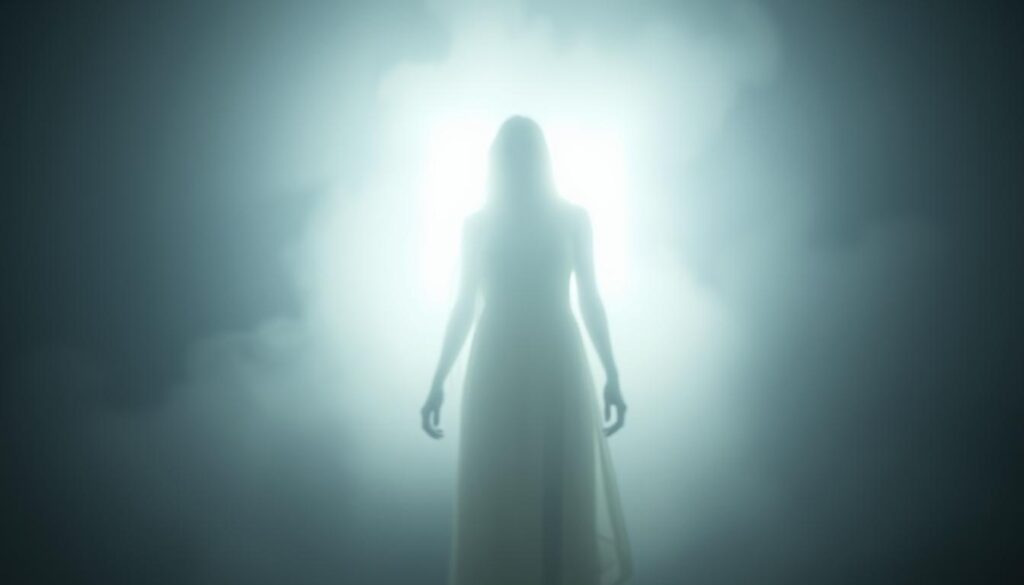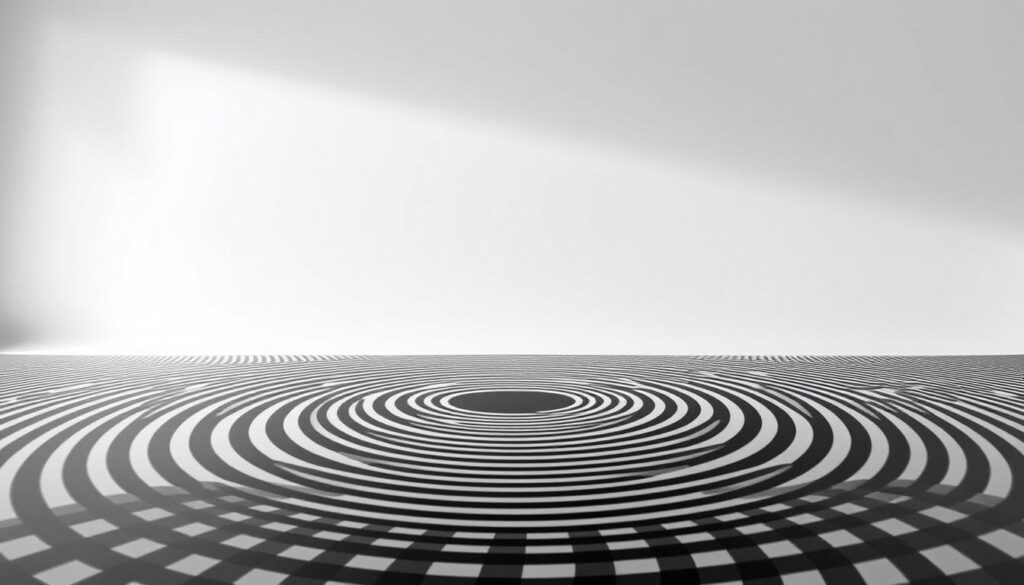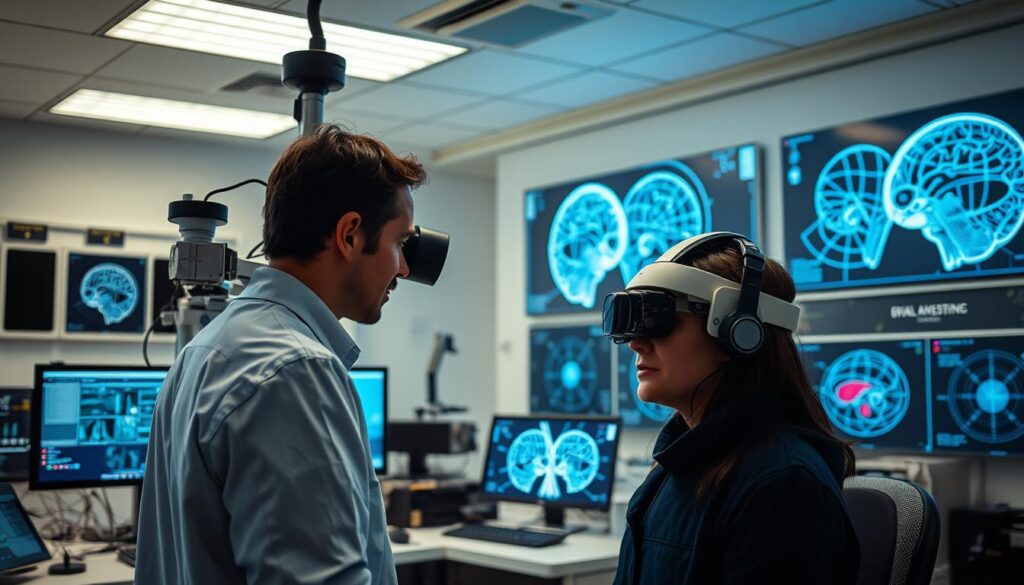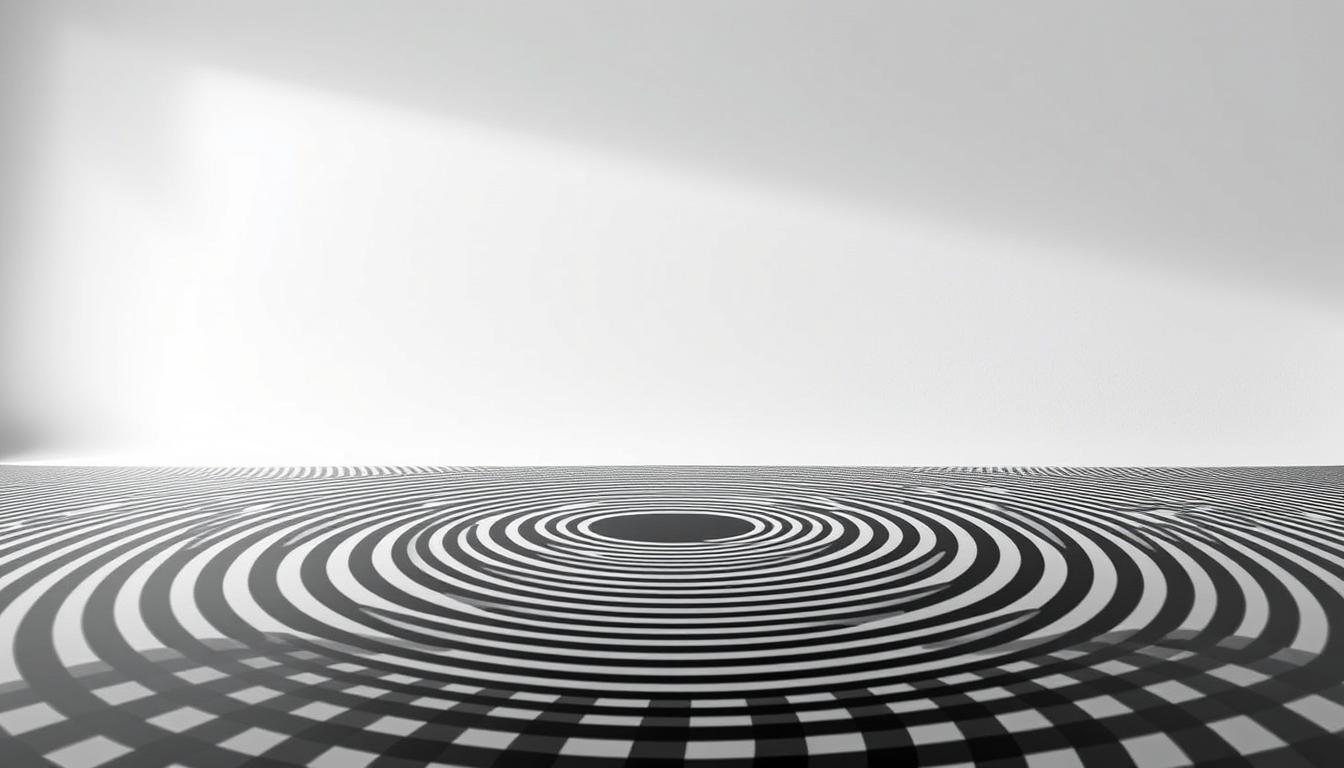Scientists and psychologists have been studying ghostly images that disappear when stared at. They are trying to figure out why this happens. This mystery has caught the attention of many, with some looking into how our brains work.
At the heart of this mystery is the ghostly image. It’s a visual trick that vanishes when you look at it closely. This has sparked a lot of curiosity about the science behind it.

Exploring optical illusions shows us how our brains can play tricks on us. The ghostly image is just one example. It shows how our eyes and brain work together, often influenced by what we see.
Introduction to Visual Illusions
Studying ghostly images and other illusions has helped us understand how our brains see the world. It shows how many things can affect what we see, including tricks of the eye.
Key Takeaways
- The ghostly image is a type of visual illusion that disappears when stared at.
- Scientists and psychologists have studied this phenomenon to understand its underlying mechanisms.
- Peripheral vision and neural adaptation play a role in creating the ghostly image effect.
- Visual illusions like the ghostly image can provide insight into how our brains process visual information.
- Understanding optical illusions can help us better appreciate the complex relationship between our eyes and our perception of reality.
The Mysterious Phenomenon of Vanishing Images
The phenomenon of vanishing images is seen in art, design, and everyday life. You might see a ghostly apparition that vanishes when you look at it straight. This staring effect is fascinating and makes you think, “What just happened?”
In our daily lives, the vanishing image effect shows up in many ways. For example:
- Optical illusions in art and design
- Visual effects in movies and TV shows
- Everyday objects that seem to vanish when stared at directly
Artists and designers have used this effect for centuries. It was used to create interesting visuals back then. Today, it’s still used in art, design, photography, and film.
Here are some common examples of the vanishing image effect in our lives:
- Looking at a picture that seems to change or disappear when stared at directly
- Seeing a ghostly apparition in a photo or video
- Experiencing the staring effect when looking at a visual illusion
These examples show how common and important the vanishing image effect is in our lives. It’s used to create interesting and thought-provoking visuals.
Understanding Visual Processing in Our Brain
Visual processing is a complex brain function. It lets us understand visual information from our surroundings. The brain uses a system of neurons and synapses to process this data.
This process involves many brain regions. Each region handles a specific part of visual processing, like color, shape, and movement.
The brain function for visual processing is very specialized. It combines information from many sources. The visual cortex, in the occipital lobe, is key for processing visual info. Then, this info goes to other brain areas for interpretation and behavior guidance.
Knowing how our brains process visual information is crucial. By studying this, researchers learn about perception and behavior. This knowledge helps in many fields, from medicine to technology. It shows us the complex processes behind human perception.
Some important parts of visual processing are:
- Color perception: the ability to detect and interpret different wavelengths of light
- Shape recognition: the ability to identify and distinguish between different shapes and forms
- Motion detection: the ability to detect and track movement
These processes help us navigate and interact with our world. They are vital for our daily lives.
The Science Behind Ghostly Images That Disappear When Stared At
When we focus on a ghostly image, it often vanishes. This happens because of how our brains work. Our brains adjust to constant sights through a process called neural adaptation. As we stare, our neurons get less active, making the image fade.
Our brains are set up to notice changes around us. When we look at one spot, our side vision kicks in. It helps us see threats or movements. But, looking at a still image for too long makes our side vision less active. This leads to the image disappearing, thanks to Troxler’s fading effect.
Learning about ghostly images disappearing when stared at helps us understand our vision better. It shows how neural adaptation, side vision, and Troxler’s fading effect work together. This knowledge is useful in art, design, and psychology, where seeing things clearly is key.
Some key factors that make ghostly images disappear include:
- Neural adaptation: the process by which our brains adjust to constant stimuli
- Peripheral vision: the ability to detect movement and changes in our visual field
- Troxler’s fading effect: the phenomenon by which static images disappear from our view when we focus on them for an extended period
Famous Examples of Vanishing Optical Illusions
Optical illusions have captivated people for centuries. The vanishing image is a fascinating type. It’s an illusion where an image seems to vanish when you look directly at it. Famous examples include the “invisible gorilla” and the “disappearing dot” illusions.
These illusions play tricks on our brains. They use how we process visual information. When we see an image, our brains fill in the gaps based on what we’ve seen before. This makes the image seem to disappear.
These illusions are not just interesting. They also teach us about how our brains work. By studying these examples, we learn more about perception and cognition.

How to Experience the Disappearing Image Effect
To see the disappearing image effect, follow a simple guide and know the best viewing conditions. This trick makes an image seem to vanish. It works by combining the right visual cues and how we see them.
This effect shows how our brain handles what we see. Learning about it helps us understand how we perceive the world. To see it, focus on the right conditions, as they affect how well you can see it.
- Start with a simple image or pattern
- Adjust the light to make the image clear
- Look at the image, then glance away
- See how the image seems to disappear
By following these steps and paying attention to the viewing conditions, you can see the disappearing image effect. It’s a cool way to see how our brain works and can teach us about perception.
The Psychology of Visual Perception
Visual perception is a complex process. It involves the brain’s interpretation and processing of visual information. The psychology of visual perception helps us understand how we see and interpret the world.
Our brain function plays a key role in visual perception. It’s a dynamic process that involves many brain areas working together. This process allows us to recognize and understand visual stimuli.
Studying visual perception offers valuable insights into our perception and behavior. Researchers learn how the brain processes visual information. This knowledge is important for fields like art, design, psychology, and neuroscience.
Several factors influence visual perception, including:
- Attention: The ability to focus on specific stimuli or features
- Expectation: The prior knowledge or expectations that influence perception
- Past experience: The previous experiences that shape our perception and interpretation of visual information
Understanding these factors helps us grasp the psychology of visual perception. It shows how it affects our daily lives. The study of visual perception is a complex field that continues to grow, offering new insights into the human brain.
Related Visual Phenomena and Illusions
Our eyes can see many things, including tricks that fool our brains. These tricks are interesting and show how our brains work. By studying them, we learn more about how we see the world.
For example, motion-induced blindness happens when moving things make us miss other sights. It’s like our brain gets distracted. Afterimages are another trick where we see something even after it’s gone.
Here are some key points to consider when exploring related visual phenomena and illusions:
- Motion-induced blindness can occur when our brains are presented with a rapidly moving visual stimulus.
- Afterimages can be used to create interesting visual effects, such as making an image appear to move or change color.
- Pattern disappearance is another example of a visual phenomenon, where our brains can become blind to certain patterns or shapes.
These visual tricks and illusions are part of the amazing world of how we see things. They show us the incredible abilities of our visual system.
Scientific Applications and Research
The study of vanishing images has many scientific applications and research areas. It includes looking into visual perception and brain function. By studying vanishing images, researchers learn more about how our brains handle visual info.
Some key research areas include:
- Understanding the neural mechanisms behind visual perception
- Exploring how attention and perception make images disappear
- Creating new ways to study brain function and visual perception
These studies could lead to new treatments for visual problems and better visual displays. By diving deeper into vanishing images, researchers can uncover more about our brains and visual perception.

The study of vanishing images is a growing field, with new findings and advancements often. As we learn more, the scientific applications and research opportunities expand.
Practical Uses in Art and Design
The phenomenon of vanishing images has many practical uses in art and design. It includes creating visual illusions and special effects. Artists and designers use it to make innovative and thought-provoking works. They show us the techniques and principles behind these effects.
In art, vanishing images add mystery and intrigue. They draw the viewer in, making them want to explore more. Artists use design principles like contrast, color, and composition to achieve this. By balancing these elements, they create tension and release, keeping the viewer engaged.
Some examples of practical uses in art and design include:
- Creating visual illusions that challenge the viewer’s perception
- Designing interactive installations that respond to the viewer’s presence
- Developing innovative design principles that push the boundaries of what is possible
In conclusion, vanishing images have many practical uses in art and design. Their applications keep growing and evolving. By understanding the principles behind this phenomenon, artists and designers can create innovative works. These works challenge and engage the viewer.
Tips for Creating Your Own Vanishing Images
Creating vanishing images needs both technical skill and creative vision. First, learn the basics of visual illusion and how to use them in your work. A key trick is to use your peripheral vision. This makes the image seem to disappear when you look directly at it.
Here are some more tips for making vanishing images:
- Use high-contrast colors to create a sense of visual tension
- Experiment with different shapes and patterns to create a sense of movement
- Pay attention to the placement of visual elements, using negative space to create a sense of depth
By following these tips and practicing, you can make your own vanishing images. They will amaze and delight your friends and family. Most importantly, have fun and be creative. The art of creating vanishing images is all about trying new things and being innovative.
Conclusion: Understanding the Magic Behind Vanishing Images
The phenomenon of vanishing images is truly fascinating. It shows how our brains can adapt and change. This effect gives us a glimpse into the amazing abilities of our visual system.
We’ve looked at how our brains adjust to these images and why they seem to disappear. We’ve also seen how this concept is used in art and design. This journey highlights the importance of studying how we see the world.
Studying vanishing images is more than just a fun topic. It opens a door to understanding our vision and minds. By diving deeper into this mystery, we learn more about ourselves and the world. The magic of vanishing images keeps us curious and eager to discover more.
FAQ
What is the science behind the phenomenon of ghostly images that disappear when stared at?
The science behind this phenomenon is quite interesting. It involves how our brains adapt to constant sights. This process makes us less aware of what we’re seeing, causing the image to fade away.
Our peripheral vision also plays a part. So does Troxler’s fading effect. These factors together create the illusion of an image vanishing when we stare at it.
What are some famous examples of vanishing optical illusions?
Famous examples include the “invisible gorilla” and the “disappearing dot” illusions. These tricks use clever techniques to make things seem to vanish when we look closely.
How can I experience the disappearing image effect for myself?
To see this effect, follow these steps: 1) Find an image or object that shows it, 2) Stand at the right distance, 3) Look straight at the center, and 4) Don’t blink or move your eyes. With the right setup, you’ll see the image fade and disappear.
What is the role of the brain in visual processing and the perception of vanishing images?
Our brain is key in how we see things. It uses a complex system to understand what we see. This includes how we notice and react to vanishing images.
By understanding how our brain works, we can learn more about why these images seem to disappear.
How are vanishing images used in art and design?
Vanishing images are useful in art and design. They help create visual tricks and special effects. Artists and designers use these tricks to make their work stand out.
They use techniques like peripheral vision and neural adaptation to achieve this effect.
What are some tips for creating your own vanishing images?
Making vanishing images takes skill and creativity. Here are some tips: 1) Learn about visual illusions and peripheral vision, 2) Try different image setups and contrast, 3) Think about how people will view it, and 4) Be patient and pay attention to details.
